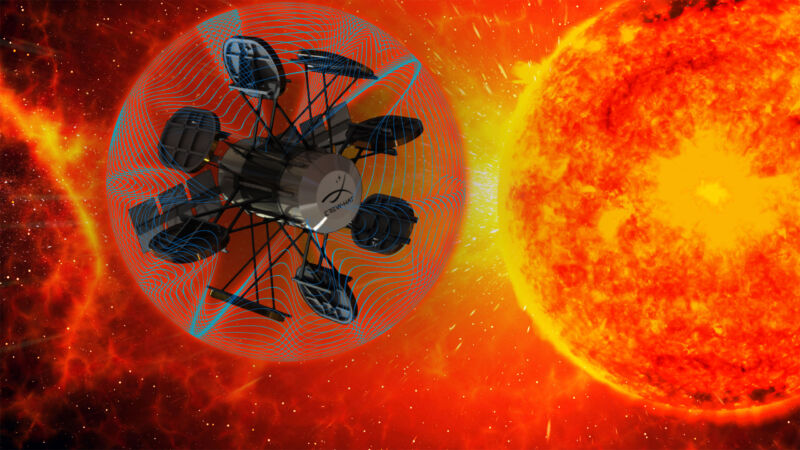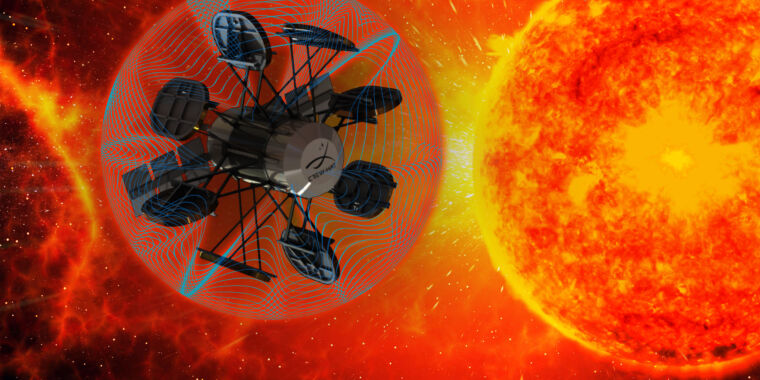Shields up: New ideas might make active shielding viable

Aurich Lawson | Getty Images | NASA
On October 19, 1989, at 12: 29 UT, a monstrous X13 class solar flare triggered a geomagnetic storm so strong that auroras lit up the skies in Japan, America, Australia, and even Germany the following day. Had you been flying around the Moon at that time, you would have absorbed well over 6 Sieverts of radiation—a dose that would most likely kill you within a month or so.
This is why the Orion spacecraft that is supposed to take humans on a Moon fly-by mission this year has a heavily shielded storm shelter for the crew. But shelters like that aren’t sufficient for a flight to Mars—Orion’s shield is designed for a 30-day mission.
To obtain protection comparable to what we enjoy on Earth would require hundreds of tons of material, and that’s simply not possible in orbit. The primary alternative—using active shields that deflect charged particles just like the Earth’s magnetic field does—was first proposed in the 1960s. Today, we’re finally close to making it work.
Deep-space radiation
Space radiation comes in two different flavors. Solar events like flares or coronal mass ejections can cause very high fluxes of charged particles (mostly protons). They’re nasty when you have no shelter but are relatively easy to shield against since solar protons are mostly low energy. The majority of solar particle events flux is between 30 Mega-electronVolts to 100 MeV and could be stopped by Orion-like shelters.
Then there are galactic cosmic rays: particles coming from outside the Solar System, set in motion by faraway supernovas or neutron stars. These are relatively rare but are coming at you all the time from all directions. They also have high energies, starting at 200 MeV and going to several GeVs, which makes them extremely penetrating. Thick masses don’t provide much shielding against them. When high-energy cosmic ray particles hit thin shields, they produce many lower-energy particles—you’d be better off with no shield at all.
The particles with energies between 70 MeV and 500 MeV are responsible for 95 percent of the radiation dose that astronauts get in space. On short flights, solar storms are the main concern because they can be quite violent and do lots of damage very quickly. The longer you fly, though, GCRs become more of an issue because their dose accumulates over time, and they can go through pretty much everything we try to put in their way.
What keeps us safe at home
The reason nearly none of this radiation can reach us is that Earth has a natural, multi-stage shielding system. It begins with its magnetic field, which deflects most of the incoming particles toward the poles. A charged particle in a magnetic field follows a curve—the stronger the field, the tighter the curve. Earth’s magnetic field is very weak and barely bends incoming particles, but it is huge, extending thousands of kilometers into space.
Anything that makes it through the magnetic field runs into the atmosphere, which, when it comes to shielding, is the equivalent of an aluminum wall that’s 3 meters thick. Finally, there is the planet itself, which essentially cuts the radiation in half since you always have 6.5 billion trillion tons of rock shielding you from the bottom.
To put that in perspective, the Apollo crew module had on average 5 grams of mass per square centimeter standing between the crew and radiation. A typical ISS module has twice that, about 10 g/cm2. The Orion shelter has 35–45 g/cm2, depending on where you sit exactly, and it weighs 36 tons. On Earth, the atmosphere alone gives you 810 g/cm2—roughly 20 times more than our best shielded spaceships.
The two options are to add more mass—which gets expensive quickly—or to shorten the length of the mission, which isn’t always possible. So solving radiation with passive mass won’t cut it for longer missions, even using the best shielding materials like polyethylene or water. This is why making a miniaturized, portable version of the Earth’s magnetic field was on the table from the first days of space exploration. Unfortunately, we discovered it was far easier said than done.
Shields up: New ideas might make active shielding viable Read More »
